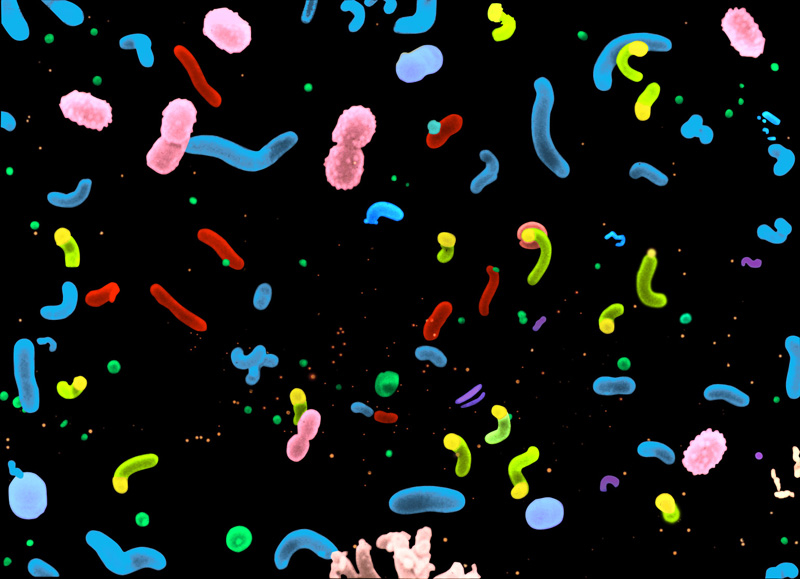
Ocean bacteria may be the ultimate synchronized swimmers.
The tiny sea dwellers coordinate the genes they turn on and off in sync with the day-night cycle — and each other, a new study shows.
The pattern, described today (July 10) in the journal Science, is driven in large part by phototrophs, or organisms such as cyanobacteria that convert solar energy into food. By turning certain genes on or off at the same times, these bacteria can share their resources, the researchers suggest.
"The solar energy that's absorbed by the phototrophs is very quickly and immediately and in great synchrony passed onto the rest of the organisms that live in the oceans," said David Karl, an oceanographer at the University of Hawaii who was part of the expedition that collected data, but did not co-author the new study. [Gallery: See Photos of Amazing Sea Creatures]
Hidden life
Though creatures such as coral, fish and sharks may be the most conspicuous sea life, the most abundant organisms in the ocean are bacteria, with about 1 billion bacteria per liter of ocean water (3.8 billion bacteria per gallon), Karl said.
Yet most marine bacteria can't be cultured in a petri dish, meaning that scientists understood relatively little about how these hidden inhabitants live. To reveal the bacteria's secret lives, DeLong and his colleagues sent a robot into the oceans around Hawaii.
Get the world’s most fascinating discoveries delivered straight to your inbox.
The robot collected water samples from about 75 feet (23 meters) below the water's surface every two hours. The robot also extracted and stored RNA, the genetic copies made from DNA that show which genes are turned on or off. After several days at sea, the robots returned to dry land.
Then, as if assembling a billion-piece puzzle using an image on a giant box top, the team matched the snippets of RNA found in the oceans with known genetic sequences for bacteria and Archaea, which are primitive microbes. From this information, they could glean which genes, in which organisms, were active throughout the day and night.
Waves of activity
The team found a distinct day-night cycle, with tightly coordinated waves of metabolic genes turning on and off in different bacterial species.
"There are tens of thousands of different species, and they're all working in lockstep," Karl said. "It's pretty remarkable."
The link to the day-night cycle wasn't surprising for light-harvesting species such as Prochlorococcus, which fix carbon into a usable form in the process of making food from sunlight.
Other phototrophs, such as the tiny marine plants known as phytoplankton, show strong synchronization to the light cycle as well.
"Most phytoplankton at least have molecular clocks that allow them to change their metabolic activities over the course of the year as day length changes," Karl told Live Science.
But metabolic genes of bacteria that feed on ocean carbon and nutrients made by Prochlorococcus were also tightly coupled to the day-night cycle, the researchers found.
Ocean ecosystem
The synchronization may be a unique adaptation to the nutrient-poor environment of the open ocean, E. Virginia Armbrust, an oceanographer at the University of Washington, wrote in an accompanying commentary in Science.
Ocean bacteria don't make all the nutrients and vitamins they need to survive, so in an extreme type of symbiosis, they may have each evolved to make just a few vitamins in the ocean, which they then supplement with nutrients from other species. By syncing their metabolisms so tightly, they can better harvest and exchange nutrients and minerals with other species, Karl said.
Follow Tia Ghose on Twitter and Google+. Follow Live Science @livescience, Facebook & Google+. Original article on Live Science.

Tia is the editor-in-chief (premium) and was formerly managing editor and senior writer for Live Science. Her work has appeared in Scientific American, Wired.com, Science News and other outlets. She holds a master's degree in bioengineering from the University of Washington, a graduate certificate in science writing from UC Santa Cruz and a bachelor's degree in mechanical engineering from the University of Texas at Austin. Tia was part of a team at the Milwaukee Journal Sentinel that published the Empty Cradles series on preterm births, which won multiple awards, including the 2012 Casey Medal for Meritorious Journalism.


